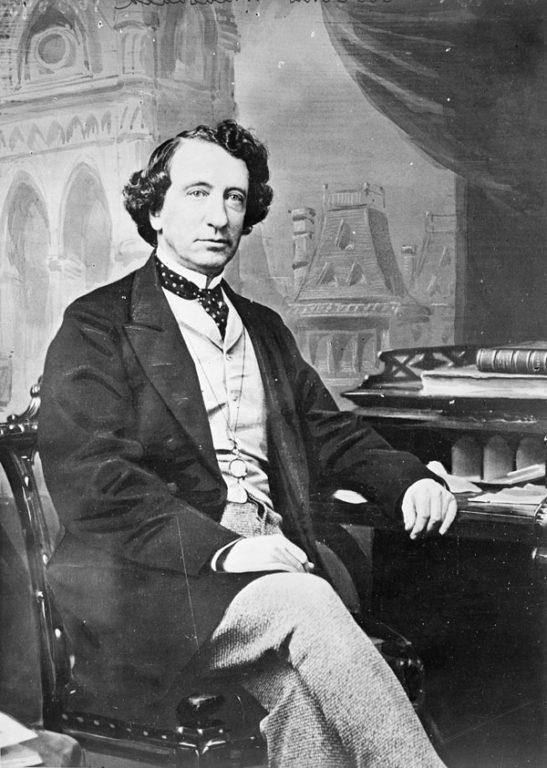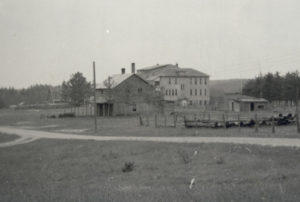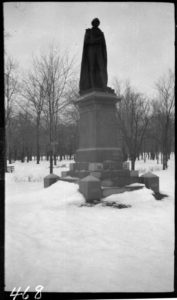Go away John A.? Kingston taking a second look at Canada’s first Prime Minister

Sir John A. Macdonald in 1868. Library and Archives Canada, 152-050 NPC, copyright expired.
The hometown
Sir John A. Macdonald (1815-1891) was Canada’s first Prime Minister and his memory is a big part of the city of Kingston, his adopted hometown. He and his family immigrated to the city from Scotland in 1820. The young John Alexander was raised there and in nearby Adolphustown and Hay Bay by the Bay of Quinte. He was educated in the city and practiced law there. He eventually lived at Bellevue, his genteel estate in the west end of the old city which is now a national historic park. Macdonald got involved in politics in the Conservative Party (the “Tories”). He became a member of the city council in 1841 and was elected to the colonial legislature in 1844, and eventually became Canada’s first Prime Minister at Confederation in 1867.
Residential schools
Macdonald’s years as Prime Minister (1867 to 1873 and again from 1878 until his death) of the newly established Canada were marked by economic policies to grow industry and expand settlement into the west. However, his government also created the Indian Residential Schools. They were set up to educate Indigenous children, but the dark part of the system was their intent to assimilate the students into white Canadian society. The schools were government-sponsored and operated by the Anglican, Roman Catholic, and United Churches, so there was also a strong effort to convert Indigenous children to Christianity.
Aside from the assimilationist underpinnings of the residential school’s system, there was also decades of physical and sexual abuse that victimized students. For many former students, their adult lives have been marked by substance abuse, mental health problems, and other tragedies as consequences of their experiences. The last residential school closed in 1996. An estimated 150,000 people attended the schools. A compensation agreement was reached between survivors and the federal government in 2007. In 2008, former Prime Minister Stephen Harper made a formal apology to the students in an emotional ceremony in Parliament.

St. John’s Residential School, Chapleau, Ontario, in June, 1941. Photo: Department of Indian and Northern Affairs. Library and Archives Canada, 6192 File Part 7, 462-5. Copyright expired. No restrictions on use.
A re-examination
The dark historical shadow of the residential schools, and the work of the federal government’s Truth and Reconciliation Commission that sought to repair the troubled relationship between Indigenous and non-Indigenous Canadians has led to many Canadians questioning how–or if–people like Sir John A. Macdonald should be commemorated. Recently, the city of Victoria, the capital of British Columbia, decided to remove a statue of Macdonald from a public place due to concerns over the residential schools issue. And now Kingston is taking a second look at Canada’s first Prime Minister.
The city is seeking feedback from residents and visitors about how Sir John A. Macdonald’s historical legacy is portrayed. It’s part of a larger “Your Stories, Our Histories” initiative. Jennifer Campbell, the city’s Manager of Cultural Heritage said the broader goal is to engage people on areas of history that have not been looked at as closely.
Plaques identifying landmarks where Sir John lived or worked are found throughout Kingston. He is buried in Cataraqui Cemetery on Sydenham Road. A major road in the city is named Sir John A. Macdonald Boulevard. There is a statue of him in the eponymously named Macdonald Park. Campbell said the statue has been occasionally vandalized by those upset about aspects of Macdonald’s legacy.

Monument to Sir John A. Macdonald, Kingston, 1916. Photo: Clifford M. Johnston. Library and Archives Canada, PA-056150. Copyright expired.
The city project allows residents and visitors to read information and submit comment cards stating what they would like to see done to honor Sir John A. Macdonald or emphasize other aspects of Canadian history in the city. Once the feedback is collected, city staff will use it in discussions with stakeholders throughout 2019.Those discussions will help determine what forms of commemoration could be used in city museums and public places. Federal historical sites like Bellevue are not under city jurisdiction and Campbell said there has not been any direct discussion with those facilities.
The City of Kingston is displaying some of the comments it has already received on the Your Stories, Our Histories website. Most are balanced comments stating that statues should not be torn down and positive legacies ignored. There seems to be a consensus suggesting the good and bad aspects of a person’s historical memory should be recognized to educate and inform the public. Suggestions included titles like “keep and contextualize,” and “You can’t learn from what you don’t see.” A couple of comments do however caution against Orwellian measures and are displeased about tax dollars being used for this initiative. However, Jennifer Campbell said no extra money beyond the yearly operating budget is being used at this time.
Canadian communities reviewing the position of Sir John A. Macdonald in public history mirrors what has been happening in some U.S. locations with statues and sites associated with the Confederacy. Both the Confederacy and Indian Residential Schools involved the subjugation of groups of people. Confronting those not so glorious parts of history and determining how to recognize them is a challenging, and potentially volatile sociological project.
Tags: canada, history, indigenous people, Kingston Ontario, Sir. John A. Macdonald





.png)

